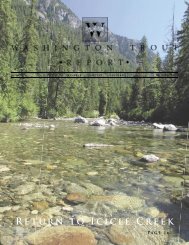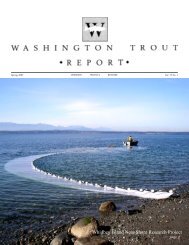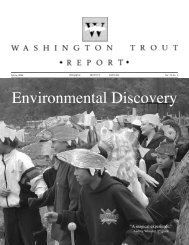Seafood Watch
Pacific Salmon - Wild Fish Conservancy
Pacific Salmon - Wild Fish Conservancy
- No tags were found...
You also want an ePaper? Increase the reach of your titles
YUMPU automatically turns print PDFs into web optimized ePapers that Google loves.
<strong>Seafood</strong> <strong>Watch</strong>® Wild Pacific Salmon Report October 8, 2010<br />
been even more severe, and read like an encyclopedia of habitat destruction: an 85% loss of<br />
coastal redwood (Sequoia sempervirens) forests, an 89% loss of Central Valley riparian forests, a<br />
90-98% decline of Sacramento River riparian and bottomland forests, a 99.9% loss of Central<br />
Valley riparian oak forest, a 94% loss of inland wetlands (including the Central Valley), a 69%<br />
loss of tule marsh, a 66-88% loss of Central Valley vernal pools, and a 62% loss of salt marshes<br />
(compiled by: (Noss et al. 1995)). Notably, Washington and Oregon both lost over a third of<br />
their wetlands between 1780 and 1980, and 91% of California’s wetlands have been drained or<br />
otherwise destroyed (Noss et al. 1995). In contrast, just 0.1% of Alaska’s wetlands were lost over<br />
that period. Indeed, Alaska is the only region of the United States without endangered<br />
ecosystems. While 11 percent of Alaska's original coastal temperate rainforests have been<br />
logged, the percentage still compares favorably against the 75-90% losses in California, Oregon,<br />
and Washington.<br />
Pollution can also be detrimental to salmon habitat. In many coastal regions, agricultural and<br />
urban run-off as well as atmospheric deposition have significantly reduced freshwater, estuarine,<br />
and coastal water quality (Boesch et al. 2001). Pollution can reduce the viability of salmon<br />
embryos, though the extent of these effects has not been quantified on West Coast salmon.<br />
Typically, agricultural chemicals such as pesticides are found in freshwater habitats at levels well<br />
below thresholds for acute mortality; however, pesticides can still cause sublethal effects that<br />
could ultimately cause ecological mortality. Potential harms include impaired swimming ability,<br />
reduced sense of smell, and disrupted immune and hormonal systems. The lack of data on the<br />
sublethal toxicity of pesticides for salmonids has been described as a “key uncertainty” for the<br />
recovery prospects of many ESUs (Sandahl et al. 2004). In 2002, a court order prohibited the<br />
application of 30 types of pesticides within close proximity to salmon waters in California,<br />
Oregon, and Washington.<br />
As with dams, this wide array of damages to salmon habitat appears to have significantly<br />
reduced both the quantity and quality of available Pacific salmon spawning habitat in the<br />
southern half of their traditional range. Alaskan habitat appears to have remained relatively<br />
robust during this period. Pollution is likewise less prominent of an issue in Alaska. While the<br />
Exxon Valdez oil spill received considerable attention for the detrimental effects it caused to<br />
salmon and other animals, current research indicates that spawning habitat has largely recovered<br />
from the spill 15 years ago (Carls et al. 2004).<br />
Introduced Species<br />
In addition to physical alterations, biological alterations to habitat can have substantial effects on<br />
salmon. In particular, introduced species can represent a subtler degradation of habitat. For<br />
example, over the past 150 years, over 20 species of fish have been introduced into the Columbia<br />
River Basin, several of which have become established. Currently, one fifth of the number of fish<br />
found in designated “wilderness area” streams in the basin are introduced species (Levin et al.<br />
2002). In many areas, introduced species are even more pervasive. For example, in a 1993<br />
survey of nearly one thousand samples (boat electrofishing, gillnets, and hoopnets) in the<br />
southern Sacramento-San Joaquin Delta, introduced species represented 99% of the total number<br />
of fish collected (Feyrer and Healey 2002).<br />
In many areas, these introductions have had significant detrimental effects on salmon. One of the<br />
most detrimental introductions is brook trout (Salvelinus fontinalis), the most abundant<br />
introduced species in threatened spring and summer-run Chinook spawning habitat in the<br />
23






